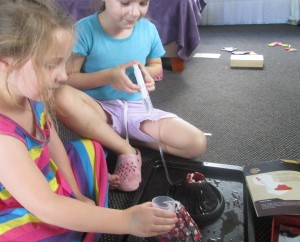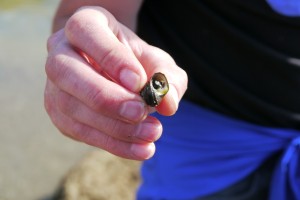Keywords: School-At-Home, Unit Studies, Primary Aged, Semi-Structured
Children: Two – 10yrs, 8yrs
We homeschool using an eclectic approach (curricula for math, planned ‘school time’ for writing, but everything else learning through living and following interests). I am self-employed, my husband works overseas and is home one week per month. I am usually up first and attend to dog, emails and some self-employed business tasks before the girls rise. Once the girls are up we all do morning chores and prepare for the day. We generally fit in a session of either maths or writing before leaving the house for activities. Math or writing ‘table work’ sessions typically last 20-30 minutes. We go out three or four days per week for activities and often add in swimming, a library visit or another unscheduled activity while we are out. Once we come home the other session (of either writing or maths) takes place, sometimes in the evening after dinner when the girls seem to work really well. Monday to Friday I prioritise math, writing and exercise every day. Everything else happens as it comes up. We are all avid learners so there are typically dozens of books being read every month, plus many organic projects on the go at any one time. From time to time we use material such as The Press education papers to direct our learning, but mostly we follow interests and expand on them. I like to use my “three minute snatch” method at the library where I grab a dozen books in a few minutes that I think the girls will find interesting – these are typically non-fiction and cover a very wide range of subjects. From these we search out further resources on topics that really grab our attention. The girls are largely self-directed for much of their time and I fit my self-employed business work around the girls’ table work and activities, as well as working most evenings.
Keywords: Unit Studies, Waldorf/Steiner, Learning-Through-Play, Preschoolers, Unstructured
Children: Two – 5yrs, 17mths
The kids like to sleep till at least 7am so we slowly get up and have breakfast at around 8am then get dressed. My oldest likes to get dressed while listening to audio books. At around 9am we head out to her art class, or we go to my toddler’s Plunket playgroup. At other times we may go see a movie or go on a field trip. A couple of mornings a week I go to the gym while they play at the kids club. At midday we come home for lunch. After lunch my toddler has a nap and this is when my daughter and I do our “work”. We start with five minutes meditation and then writing practice. We also do a variety of maths activities (worksheets, computer games, money and time games or other activities) which my daughter loves. We will usually then take some time to explore some other topic which has caught her interest during the day/week. This ranges from amphibians, the royal family, evolution, volcanoes, etc. We may read some stories together. Then my youngest one wakes and we have afternoon tea followed by free play. After dinner and bath time, it’s story time. We read at least four books every night before bed – at the moment it’s lots of traditional and exotic fairy tales. The kids are in bed early, around 7pm. After that my husband and I catch up on some work, adult time, plan for the next day or just relax with a book.
Keywords: School-At-Home, Unit Studies, Large Family, Teens, Primary Aged, Structured
Children: Eight – 19yrs, 18yrs, 17yrs, 15yrs, 12yrs, 11yrs, 8yrs, 6yrs
We start at 9.30am every day and finish at 12.30pm. Monday to Thursday our schedule runs: Bible study, scripture copy work, spelling, reading/English, math, scripture memorization, foreign language lessons, music practise, and reading aloud. On Fridays we cover history, science, and our current unit study or lap book project. All afternoons are for free time, exploring, field trips, research, chores, etc. My two oldest have graduated from their homeschool. The 19yr old worked a year in our family business and is now doing his OE in Europe. Our 18yr old is in his first year of farming doing on-the-job training and the primary ITO course (theory side of things).
Keywords: Classical, Charlotte Mason, Unit Studies, Primary Aged, Structured
Children: Two – 11yrs, 8yrs
The girls always follow a timetable as I find it is the only way of making certain that by the end of the week we have covered the correct amount of each subject and we get to our group classes on time! We always do maths, literacy, instrument practise and exercise daily. Then we add in geography, history, Spanish, Latin, biology, physics, chemistry, technology, personal project time, programming, art and music theory. A typical day for my eight year old might be … maths, personal project time, geography, art-history (combining literacy), dance class, instrument practise, and touch typing. A typical day for my eleven year old might be … physics (combining maths), personal project time, grammar, geography, history (combining literacy), dance class, instrument practise, and art. We try to see friends every day and this is often during a class. Although we pack a lot into our day, the children only work the same hours as they did at school. That frees up all the time before and after school because there is no travelling time, no homework and even instrument practise takes place during the day when the girls are still feeling fresh! We always do our academics in the morning and leave the afternoons, whenever we can, for exercise, technology, music and art. We have a different focus each term – we have had fitness terms, exam terms, arts terms and unit study terms. The amazing thing about homeschooling is that you are not locked into a whole year of something.
Keywords: Montessori, Classical, Unit Studies, Primary Aged, Preschoolers, Travelling, Semi-Structured
Children: Three – 7yrs, 5yrs, 3yrs
My family travels through the winter months in NZ or Australia, following my husband as he works onsite. Sometimes we are in the same place for a month, often it’s just a week and then we move to a new location. We are away 3-4 months and then return home in the spring. Where-ever we go we try to connect with the local home education groups. I now know that it’s key to get involved in a few activities straight away (I pre-organise these from home if possible) as it doesn’t take long for isolation to create a negative home environment. I followed the Montessori method for home education. Packing can be a challenge, I simply can’t pack all of the materials we normally use so we bring a few key things and improvise. My oldest is moving away from Montessori activities, though will still tinker with what the younger ones are using. His mornings revolve around lessons more in the Classical style – spelling, language, French, dictation, narration and piano. We use a combination of math resources including some of the Montessori tactile materials, workbooks, online programs – and try to make each day a little different. John Bowman’s ebook “Montessori at Home” has been most helpful with organising activities for young ones out of what we have on hand or can pick up cheaply from a local store. Occasionally my youngest has her own lessons when exploring something new (eg. number and letter recognition) and she is always involved in a craft afternoon! We try to plan two full days at home so that I can work with my two older ones on history, unit studies, and reading during my three year olds nap time. The other days are punctuated by library visits, storytime, music lessons and activities which may include gymnastics, ballet, swimming, art classes or other sports. A few full days out of schedule each term gives everybody the opportunity to take a break. While we’re away this winter the children and I have planned an exploring afternoon each week, we’ll have an early lunch then head off to visit something local.
Keywords: Classical, Charlotte Mason, Unit Studies, Teens, Semi-Structured
Children: Four – 21yrs, 19yrs, 17yrs, 14yrs
We have been home educating for 14 years. My older two are now working and life is very different from when we first started. Would I do it all again? Yes, in a heartbeat. It was one of the best decisions we ever made. As the children have gotten older we have built more flexibility into our schedule. We started homeschooling when the kids were 7yrs, 5yrs, 3yrs, and six months. During this time we usually did five weeks on and one week off, with a longer break part way through the year and at Christmas. A typical day would involve me getting everyone up, dressed and fed; a few chores done, then we’d have devotions and read aloud together (with youngest one back in bed or playing nearby). After that we’d do a mixture of bookwork and activities (eg, maths manipulatives, puzzles, drawing, etc), interspersed with one-on-one time reading on the couch. Then we’d take a break while I fed the baby and did some one-on-one work with the older two. After lunch we would head out to the library, park or an activity such as sports group; or have rest time (reading, audio books, Lego, etc); or outside play. Once the youngest dropped her morning nap she was up at the table with us and loved her school activities. Through the middle years we generally fit in with the school terms but took time off from our usual routines when interesting opportunities came up. This was a very busy time when it was the most hands-on with all the kids’ learning. The day worked best with getting some chores done before starting learning activities. We’d start the day about 9am with devotions and history reading, narrations or activities all together. The kids liked to each have a “Weekly Plan” to follow in the order they chose – with their learning activities for each day listed (eg. maths, reading, spelling, Latin, writing, logic games, music practice, science, or a topic they were interested in). Not every subject was every day. Some days it would say “see Mum” and we’d do it together. Sometimes we’d take a week or month off and do a unit study or lapbooks all together and then do individual maths and music practices. The high school years were where our homeschooling got both messy and exciting! The habits and foundations of the earlier years were really helpful in that the kids had been exposed to a wide variety of experiences and topics, and we had lots of opportunity to see where their strengths and interests lay – they were ready to tackle anything that appealed. Self paced curricula worked really well during the teen years for all of my children. We continued to read aloud and have robust discussions, tackling a mixture of biographies, adventures, classics, tough issues and devotional books. Sometimes I found literature guides helpful to expand our discussions. All my teens continued honing their writing skills independently and as part of a group. Writing was often in the context of research and presentation on topics that interested them. We took advantage of a lot of opportunities such as being ‘model’ students for outdoor education courses, free computing classes at polytech, first aid courses, music opportunities, community night classes, and participation in things available through our church. Volunteering led to part time jobs, and both of my older ones got into tertiary courses based on their portfolio and entrance test.



